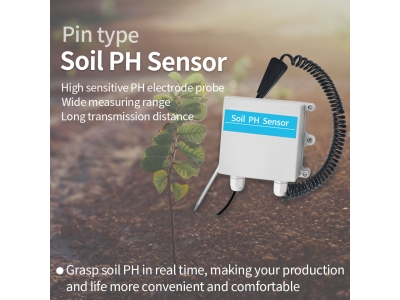Farming practices have evolved significantly over the years, driven by advancements in technology and the need for sustainable agriculture. One such technological innovation that is transforming farming is the use of soil sensors. These sensors provide valuable insights into soil conditions, allowing farmers to make data-driven decisions and optimize their farming practices. This article aims to explore how soil sensors are enhancing farming practices, discussing their technology, applications, benefits, and challenges.
Understanding Soil Sensors:
a. Definition:
Soil sensors are devices or systems designed to measure and collect data on various soil parameters, including moisture levels, temperature, nutrient content, and pH.
b. Types of Soil Sensors:
There are different types of soil sensors available, each with its own unique sensing mechanism. Some common types include capacitance sensors, tensiometers, gypsum blocks, and electrical conductivity (EC) sensors. Each type provides specific information about the soil conditions.
Applications of Soil Sensors:
a. Irrigation Management:
One of the primary applications of soil sensors is in irrigation management. By monitoring soil moisture levels, farmers can determine when and how much water to apply. This helps prevent over-irrigation or under-irrigation, leading to improved water use efficiency and healthier plant growth.

b. Nutrient Management:
Soil sensors play a crucial role in optimizing nutrient management. They provide real-time data on the nutrient content of the soil, allowing farmers to adjust fertilizer applications accordingly. This helps ensure that crops receive the optimal amount of nutrients, reducing the risk of nutrient deficiencies or excesses.
c. Disease and Pest Management:
Soil sensors can detect changes in soil conditions that may be indicative of disease or pest infestations. For example, changes in soil moisture, temperature, or electrical conductivity can signal the presence of pathogens or pests. By monitoring these parameters, farmers can take preventive measures to minimize crop losses.
Benefits of Soil Sensor Technology:
a. Precision Agriculture:
Soil sensor technology enables precision agriculture, where farmers can make targeted, site-specific decisions based on real-time data. By understanding the variability in soil conditions across their fields, farmers can apply inputs such as water, fertilizers, and pesticides precisely where needed. This optimizes resource allocation, reduces waste, and improves overall farm efficiency.
b. Water Conservation:
Effective irrigation management using soil sensors helps conserve water resources. By applying water only when necessary and avoiding over-irrigation, farmers can minimize water waste and reduce their environmental impact. This is particularly important in water-scarce regions or during drought conditions.
c. Optimized Nutrient Use:
By monitoring soil nutrient levels with soil sensors, farmers can adjust fertilizer applications according to the specific needs of their crops. This improves nutrient use efficiency, reduces fertilizer runoff, and minimizes the risk of water pollution. It also leads to cost savings for farmers through reduced fertilizer inputs.
d. Enhanced Crop Quality and Yield:
By providing accurate data on soil conditions, soil sensors enable farmers to optimize their farming practices and create conditions favorable for crop growth. This, in turn, leads to improved crop quality and higher yields, contributing to increased profitability and food security.
Challenges of Soil Sensor Technology:
a. Data Interpretation:
Interpreting the data collected by soil sensors requires knowledge and expertise in soil science and agronomy. Farmers may need assistance or training to understand and effectively utilize the sensor data for decision-making.
b. Sensor Calibration and Maintenance:
To ensure accurate and reliable data, soil sensors require regular calibration and maintenance. Malfunctioning sensors or improper calibration can lead to inaccurate readings, affecting the effectiveness of farming decisions based on sensor data.
c. Cost and Accessibility:
The initial cost of implementing soil sensor systems can be a barrier for some farmers, particularly small-scale producers. Additionally, access to soil sensor technology may be limited in certain regions or developing countries, hindering widespread adoption.
The Future of Soil Sensor Technology:
Advancements in technology are driving the development of more sophisticated, user-friendly, and affordable soil sensors. Wireless connectivity and data analytics tools are improving data collection, interpretation, and decision support. Integration with other technologies, such as satellite imagery, drones, and artificial intelligence, holds promise for further enhancing the efficiency and effectiveness of soil sensor-based farming practices.
Conclusion:
Soil sensors are revolutionizing farming practices by providing





